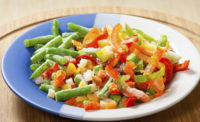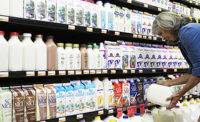Food safety, healthy eating, food waste and big flavors are on the menu for 2016, according to a 2016 trends report released by Oklahoma State University’s Robert M. Kerr Food & Agricultural Products Center (FAPC), Stillwater, Okla.
“Businesses need to pay attention to trends in order to find new growth opportunities and their target audiences,” says Andrea Graves, FAPC business planning and marketing specialist. “Understanding these trends help businesses stay ahead of upcoming change, whether it is regulatory or a new flavor profile. Also, in most cases, consumers drive the trends and are looking for products and companies that are meeting their needs and lifestyles.”
Here are the Top 16 trends:
1. New food safety demands for small businesses.
Due to customer and regulatory demands, smaller food companies will need to implement preventative controls to meet the Food Safety Modernization Act requirements, which will become mandatory in three years. “Big-box” stores are now demanding third-party audits from suppliers of all sizes to help reduce food safety risks.
2. Ethics.
Consumers, particularly Millennials, are choosing to support businesses perceived as being ethical. They will purchase one product over another regardless of price if they believe the company maintains good core beliefs and appears to practice those beliefs.
3. Food application technology.
Fast food entities and restaurants, such as Taco Bell and Olive Garden, have started offering applications for mobile devices. These apps make it convenient for ordering, delivery or pickup. This food trend will continue to satisfy the convenience factor younger populations want.
4. Children’s health.
Many restaurants are changing their kid’s menu to provide a healthy choice such as grilled chicken for all customers. Some foodservice operations have also started to remove soda from their menus.
5. Food waste reduction.
Reducing food waste is a rising environmental issue. Foods that were once considered “too ugly” to eat will be used instead of discarding. There is a need to make the reduction of food waste important to chefs across the nation.
6. New cuts of meat.
With commodity prices for beef rising, chefs are utilizing relatively new or unutilized cuts, such as the Vegas Strip Steak and shoulder tenders for new recipes.
7. Transparency.
Consumers want the origin of the food they buy to be transparent. This new trend is increasing the want for certain items to come with a special label. And, studies say 34% percent of customers would be willing to pay more for the transparency of food products.
8. Natural foods.
Many food processors have removed artificial ingredients from their products due to the demand for all-natural items from the younger population.
9. Locally grown produce.
Chefs predict that in 2016, more restaurants will incorporate locally grown produce in their ingredients list. This will support local farmers and fulfill the customer’s want for transparency in the items they eat.
10. Having a story.
It is not enough to just have a well-branded and delicious food product. Consumers want to know where their food comes from as well as the background story behind the manufacturer.
11. Comfort foods.
In 2015, more consumers went toward the food from their roots, such as traditional meatloaf, chicken soup and macaroni. This trend is sure to advance in 2016, as more people start to crave comfort foods.
12. Meal kit foods.
Many large food companies are starting to produce meal kits for convenience. These meals include everything you need, but the meat. If you want a more convenient meal kit, there are delivery options, complete with pre-measured ingredients packaged in separate compartments; all you need to do is put them together and cook.
13. Big flavors.
Fresh herbs, flowers, olives, wild garlic, cucumber and fennel are beginning to trend as big flavors.
14. Artisanal foods.
Foods such as hand-crafted breads, pastries, cheese and chocolate are defined as artisanal. They offer an authentic and fresh quality that consumers are craving.
15. Customized foods.
As consumers become more and more educated about food through the ease of the Internet and social media, the demand for customized foods will rise in the coming years. However, U.S. consumers are still reluctant in opening their wallets wide, but still want a sample of what the world has to offer. The demand for small tastes of quality foods at a reasonable price will rise in 2016.
16. Food incubators.
More and more food entrepreneurs are using food incubators, or shared commercial kitchens, to develop, test and commercialize their food products in a licensed, health-inspected space.



